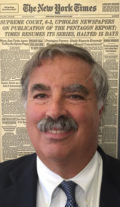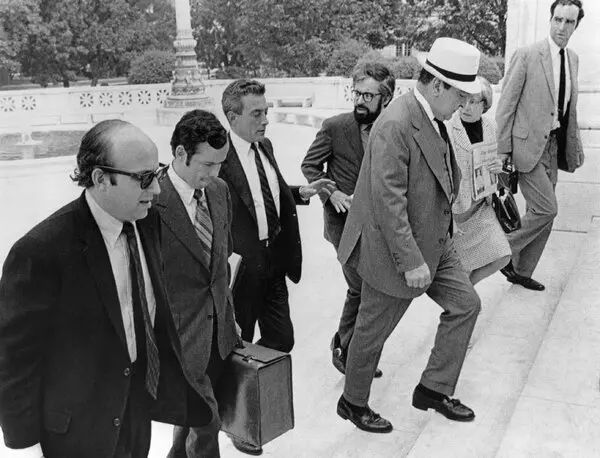A New Film: Floyd Abrams – Speaking Freely
A Biopic About the First Amendment

Media lawyers live busy lives. We deal with discovery deadlines, fine tuning footnotes in briefs, office committees and politics; we pay attention to the needs of family members, be they spouses or children, do some household chores, and prepare for social events; and maybe we have time to sneak in a PT session or an hour of tennis or a favorite tv show somewhere in between.
What we generally don’t have time for is the big picture, not about the details of our practice, but about why we do what we do: what, at bottom, is the “central meaning” of the First Amendment, what is its purpose and history, how did the First Amendment precedents we cite develop, and why really is what we do so important.

Now, a 83 minute film answers those questions. It is entitled “Floyd Abrams: Speaking Freely” and it will be shown on your local PBS station on Friday, September 22 as part of the American Masters series. See the trailer here. Though the hero of the piece appears to be Floyd, the co-hero really is our Constitution, in particular the First Amendment. (Query whether it’s a coincidence that Floyd’s initials are also FA.)
Before I get into the substance of this biopic, I should give a bias alert. I have known Floyd for almost 50 years, and consider him a close friend as well as a mentor. We first met when I was a summer associate at Cahill Gordon, and gathered up the courage to walk into his office and ask for some work. “You’re just the man I’m looking for,” he smiled, as I dreamed of being in the Supreme Court the next month. Instead, he off-loaded a German bank bankruptcy case on me, not exactly what I was looking for. But as Rick tells Captain Renault in the last line of Casablanca, it was the beginning of a beautiful friendship.
A few years later Floyd asked me to do some work on Herbert v. Lando, a case where CBS was trying to harshly limit discovery of its journalists in a public-figure libel case. As he explained the case to me, I interjected, “but how then would a plaintiff even have a chance to prove actual malice.” He visibly sagged, chagrinned that a junior associate would take a non-supportive position – but evidence that Floyd was perhaps the only partner I had seen who actually listened to, and cared about, what a young lawyer might say. The film touches on the Herbert case, too: Floyd managed to win in the Second Circuit 2-1, but then was shutout in the Supreme Court.
Our relationship was not always so work-related. When I was in-house, I remember complaining about a Cahill bill, and he invited me to lunch to discuss it. We spent the entire lunch discussing politics and the pro wrestlers of the 1960’s; the bills never came up. And I recall calling him often on weekends during our Judy Miller saga. I usually found him walking in Central Park, a transistor radio pressed to his ears listening to Yankee games.

While the movie shows glimpses of Floyd’s personality – his humor, graciousness, love of family, and sensitivity – the main focus is on the cases. And what a series of landmark First Amendment cases it depicts. It starts with Floyd’s victory for the Brooklyn Museum against Mayor Giuliani in a case where New York sought to censor and punish the showing of some controversial and purportedly salacious artwork. But it then goes back to the first series of First Amendment cases in the World War I era and, of course, Times v. Sullivan. And then starts the long line of cases Floyd was involved with starting with the Pentagon Papers case, segueing into a series of prior restraint cases, and then, in the summer of 1978, two groundbreaking cases Floyd worked on simultaneously — the Niemi copycat case, in which NBC was sued for showing a drama including a rape scene which may have inspired a somewhat similar rape of the plaintiff days later, and the case resulting in the jailing of Times reporter Myron Farber for refusing to testify as to his sources in the New Jersey “Dr. X” criminal case. (I was at Cahill at the time, preparing for trial in a Title VII class action case against the Times, and remember the chaos well.)
The list of significant cases Floyd fought in which strong First Amendment doctrines were developed goes well beyond the above, and they all are extremely well summarized by the moviemakers – lovely and detailed videos, an explanation of the facts and the law which makes the cases accessible to lawyers and laymen alike, and, perhaps most poignantly, the explanation for why these cases, and fighting for press freedoms, is so important to our country and our democracy.
The one quality the film slightly underplays is how moderate Floyd really is. He is not an unbounded First Amendment flag-waver (or liberal). He goes only so far as reason and sound judgement allows.

The story is told not only through extraordinary historical video clips, but also through interviews with Floyd’s clients, colleagues, journalists and scholars. Nina Totenberg talks about being represented by Floyd when she was subpoenaed by the Senate to testify at the Anita Hill/Clarence Thomas confirmation hearings; Ted Olson talks about why he sought Floyd’s help notwithstanding their political differences; Prof. David Rudenstine, author of a book about the Pentagon Papers case, explains what happened behind the scenes and why it was so significant; Adam Liptak, who worked with Floyd at Cahill and then covered him as the New York Times legal and Supreme Court correspondent, discusses Floyd’s consistent fealty to the First Amendment whatever the facts and politics; and Lee Bollinger, former President of Columbia University, puts it all in a historical perspective.
Although Floyd is certainly the hero of the piece, and universally viewed in the film as “the first First Amendment lawyer,” and one of the press’s greatest and most significant advocates, the last third of the film raises critical questions. It focuses on his support of Sen. Mitch McConnell in the Citizens United case, where many of his staunchest allies opposed his argument in favor of corporations’ rights to make huge monetary contributions in elections, albeit as a form of political speech. And it questions his supporting a company that sells facial recognition technology to the government, despite the potential conflicts with individuals’ privacy rights.
Thus, the film ends with questions raised by the situation we find ourselves in today. How do we balance the infirmities of rampant disinformation, hate speech, the impact of money in politics, and the invasion of privacy brought on by new technologies with our tradition of free speech and a free press. Floyd is shown troubled by these developments, but continuing to advocate for our traditional broad First Amendment protections even in these new iterations, while acknowledging the increasingly heavy price we pay for these freedoms.

Quite a few scenes show Floyd throwing out old files, as his firm prepares for moving office buildings. In a movie worked on for over three years, where hours of incisive interviews and memorable old news clips were left on the cutting-room floor, why spend time showing a senior lawyer tossing thick redwell legal folders into a garbage bin? The filmmakers say that these scenes personalize Floyd. But I think it’s something more. What he was throwing out was history: his notes, papers, briefs in momentous cases over half a century. Although he was wistfully throwing them out, they represented the struggles he waged on behalf of free expression, the battles he won which have made our country‘s law the most press protective in the world. (Floyd humorously mocks surveys which rank the Scandinavian countries higher on the scale of press freedoms.) The truth is that history never gets forgotten. It is the very basis for how we must continue the campaign for free expression, even in today’s problematic environment.
The film, then, is at once a biopic of Floyd and a biopic of the First Amendment. Sometimes I get criticized for putting on too many programs about old cases and issues which occurred before some of our members went to law school or were even born. But beyond the fact that these issues tend to recur, albeit in newer and different contexts, they all are important parts of our historical fabric, the structural base and centerpiece for the principles we believe in and the arguments we make today. Not only to get pumped up, and more than just to learn some legal history, I urge all members to watch this film on the 22nd. It will renew your faith and dedication to the goals and principles we are striving for.
George Freeman is executive director of the Media Law Resource Center, and the views expressed are his and not those of the organization. Comments on this column are welcomed at gfreeman@medialaw.org; they may be featured in next month’s LawLetter.